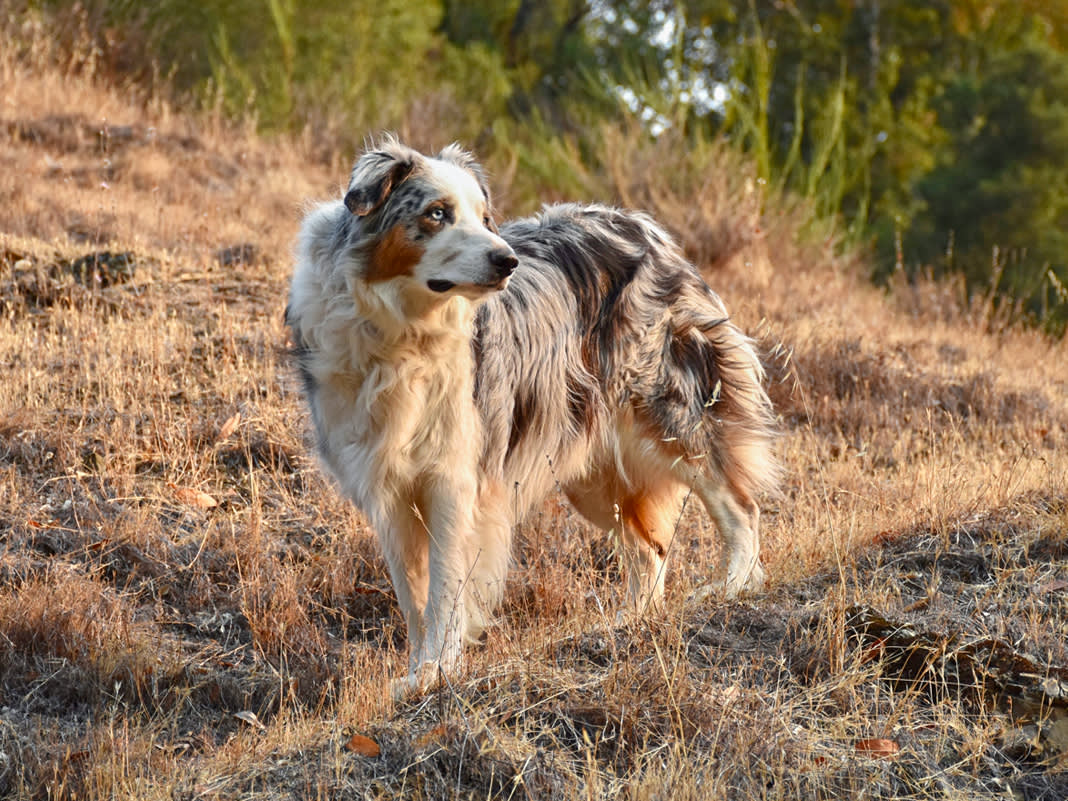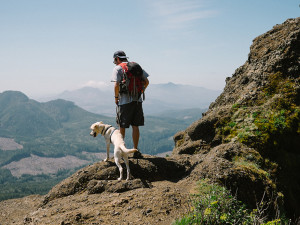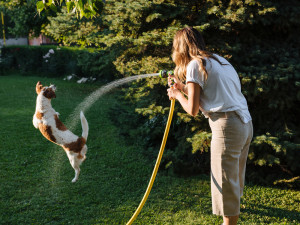How to Hike Safely With Your Dog This Summer
Time to get your gear—and your pup—ready to go.

Share Article
When summer comes around, the opportunities to exercise with your dog explode: You can take a dipopens in new tab in a pool together, hop in a canoe (just keep an eye out for toxic blue-green algae), or — if your pup’s extra adventurous — even catch a wave. And for those who prefer to stick to land, it’s the perfect time to take your pup for a hike on a local trail. If exploring nature with your dog sounds like the ideal summer day, then lace up those boots, pack up your bag, and keep these tips in mind while you set out on your adventure.
Can I go hiking with my dog?
Short answer: Absolutely. Just be sure you know what to expect — for both your pup and yourself. Go easy when you start out; know your own fitness level, and don’t feel like you have to attack the trail.
When it comes to clothing, be sure to dress in layers. A backpack is a convenient placeopens in new tab to stow a sweatshirt if you begin to overheat. But above all, focus on having the proper footwear. A raincoat will keep you mostly dry, but hiking in soggy shoes is a nightmare. I got in the habit of throwing three pairs of footwear in the car before I left: sneakers, hiking shoes, and rain boots. You can never know exactly what conditions to expect, so give yourself the option to make a game-time decision.
What essential items should I bring for my dog on a hike?
There are a few hiking essentials for dogs you should always bring. One of the most important things you can do for your pup is to protect them from ticks. Dogs can get seriously ill from ticks, and a hiking trail is likely full of more ticks than your usual neighborhood sidewalk. NexGardopens in new tab is a chewable preventative that stops ticks from biting in the first place, and one dose lasts a whole month. But even if you use a preventative, be sure to still periodically check your dog for ticks. My dog’s white fur makes them easier to spot, but his long hair helps them hide. (Remember, ticks can be tiny, so you have to be thorough — you really don’t want to bring them home.)

Some more dog hiking essentials: In any season, extra drinking water is a necessity. I always carry a collapsible dog bowlopens in new tab or water bottleopens in new tab made especially for dogs with a built-in dispenser. Either one fits conveniently into a backpack and makes it easy to stop and admire the view while your pup hydrates. Another must? Poop bagsopens in new tab. Some trails have dispensers at the trailhead, but don’t count on it. Always pick up after your dog; it’s polite to your fellow hikers, and it’s better for the environment.
How do I prepare my dog for a hike?
When you’re taking your dog on a hike, there are a few tips that can make sure you’re both prepared:
1. Start with short, smooth trails.
Before you go all-in on an intense hike, try some easier trails with your pup. And if your pup hasn’t had their annual check-up, make sure you see a vet before you head out.
2. Research dog-friendly hikes.
Look up the best dog-friendly trails in your area, and be sure dogs are allowed on the path you want to hike.
3. Pack a dog first-aid kit.
Make sure you bring a few first aid items, just in case an injury happens while you’re far from home. Pack alcohol wipes, bandages, tweezers, and Benadryl.
4. Prepare a small dog.
If you’re hiking with a small dog, be aware that they might not be able to go as far as large breeds. You may need to spend some time building up their strength and endurance before you head out on your hike.
How can we get to know the trail?
Do your homework when you’re researching the best hiking trails that are dog friendly: During which hours are dogs allowed? Do they need to be leashed? I prefer trails where dogs may be off-leash but must be under voice control, which means your dog will actually need to come when called. Keep in mind that you could be sharing the trail with other hikers (human and canine), cyclists, horseback riders, and, of course, wildlife. Make sure you’re not putting your dog, yourself, or others in danger.
Are there any hiking trails where dogs are not allowed?
There are hundreds of miles of spectacular trails where I live. Some take me to the ocean, while others go to the hills, and guessing which trails allow dogs isn’t always intuitive. A quick Google search in advance should sort you out — there may already be a list of the best dog-friendly hiking trails in your area. Local, state, and national parks all have different policies when it comes to dogs. A fun place to start is with a map of National Parksopens in new tab that allow pets.
Can I let my dog swim in lakes or streams during the hike?
If you want to take your dog in the water when you’re hiking, here are a few pointers:
Larger lakes are generally safe for dogs, but avoid lakes with algae on the surface because it can be toxic to dogs. Learn how to recognize blue-green algae, which is highly toxic to dogs. Never take your dog in a body of water that looks stagnant or dirty.
Small shallow streams are generally safe for dog swimming — just look out for any sharp objects that could injure them.
In general, make sure your dog can actually swim before letting them in the water! And don’t let them swim out too far where you couldn’t rescue them if needed.
FAQs (People Also Ask):
1) How can I keep my dog safe during the hike?
Keep your dog safe during a hike by making sure they are up to the task fitness-wise and in good health. Also, bring water and snacks and a first aid kit.
2) Should I pack extra food for my dog during a hike?
Yes, you should always pack snacks, water, and a little extra food for your dog during a hike, just in case it takes longer than you think it will with them on the trail.
3) What if my dog is not used to other dogs or people on the trail?
It's best to try to socialize your dog with other pups and humans before you set out on a hike. No matter what, remain calm when you encounter dogs and people on the trail.
4) How far can dogs hike?
Most healthy dogs can hike between 10 to 20 miles, but it also depends on your dog's age, breed, activity level, size, and stamina.
References:
US Forest Service Hiking and Camping With Dogsopens in new tab
How to Safely Hike, Camp, and Backpack With Your Dogopens in new tab
Lone Tree Veterinary Medical Center: Where Should Your Dog Swimopens in new tab
The Hiking Authority: How Far Can a Dog Hikeopens in new tab
AKC: Hiking With Dogs: Tips for Hitting the Trailopens in new tab

William Wayland
William Wayland is a writer, photographer, and dog parent to two cats and a dog (and a husband and father to two human boys). Though best known for his event and live music photography, William aspires to photograph every dog in the San Francisco Bay Area. Follow his dog’s adventures on Instagram @quinceytheaussie.
Related articles
![Woman holding a beagle in warm dappled summer light]()
You’ve Got a Summer-Lovin’ Pup. Here’s How to Keep Them Safe
Some like it hot (but not most dogs). Here are the season’s health hazards, from fleas to foxtails.
![Dog on leash running in a field without foxtails]()
Why Foxtails Are So Dangerous for Your Dog
Late spring is prime time for these blades of grass that pose a serious risk to your pup.
![A woman spraying her excited dog with a garden hose in the grassy backyard]()
7 End-of-Summer Activities for You and Your Dog
Stay cool (and safe) out there.
![Dave looks down at his dog Stanley, with the sea and rock cliffs in the background.]()
5 Dog-Friendly Nature Spots around LA for Hiking, Camping & Zenning Out
LA wellness guru Dave Coastopens in new tab shares his favorite places to escape the city with his Poodle.
![A tattooed blonde woman wearing a white hat looking at her black and tan dog while a Springer pet water bottle sits on a rock behind her on the trail outdoors]()
A Sustainable Dog Water Bottle?
We’ll drink to that.






